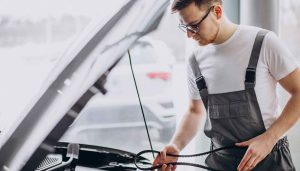By maintaining your car yourself, you not only save money, but you also extend the life of your car. Regular maintenance can help prevent unexpected breakdowns and expensive repairs. DIY car maintenance can provide a sense of satisfaction and give you a better understanding of your vehicle, resulting in a safer driving experience.
Essential tools for DIY car care
To get started with DIY car care, you need the right tools. Basic tools include socket wrenches, screwdrivers, wrenches, pliers and jacks. For more advanced tasks, consider an oil filter wrench, a torque wrench, and a multimeter. Don’t forget to protect yourself with safety equipment such as gloves and goggles.
How to change engine oil
Changing your car’s oil is one of the most important maintenance tasks. You will need new oil, oil filter, keys and oil pan. Let the engine warm up first and then drain the old oil by removing the drain plug. Replace the oil filter, replace the drain plug and fill the engine with new oil. Properly disposing of used oil is critical; take it to a recycling center.
Check and replace air filter
A clean air filter is critical to engine performance and fuel economy. Remove the air filter from the housing and hold it up to the light for inspection. If you see light coming from the filter, the filter is still working; if not, it must be replaced. Replacing the air filter is simple: remove the old filter and install the new one.
Check and replace spark plugs
Spark plugs play a crucial role in engine performance. Worn spark plugs can cause misfires and poor fuel economy. Remove the spark plug and inspect it for wear or deposits. If the spark plug looks worn, replace it with a new one bolted on to the correct torque.
Tire maintenance tips
Good tire maintenance guarantees safety and extends the life of the tires. Check tire pressure regularly with a pressure gauge and keep it at the level recommended by the manufacturer. Check the tread depth with a tread depth gauge or coin test. Rotate the tires every 9,000 to 13,000 miles to promote even wear.
Replace windshield wipers
Clear vision is essential for safe driving. If the windshield wipers leave streaks or make noise, replace them. To replace it, lift the wiper arm, remove the old wiper, and install the new wiper according to the manufacturer’s instructions.
Battery maintenance
A well-maintained battery ensures that your car starts reliably. Check the battery for corrosion and, if necessary, clean the terminals with a mixture of baking soda and water. Test the battery power with a multimeter. If the battery is aging or shows signs of failure, replace it.
Maintenance of the brakes
Brakes are critical to safety. Check the brake pads for wear by looking at the wheels or removing the tires. If the brake pads are less than 1/4 inch thick, they need to be replaced. Check the brake fluid level and top up if necessary. Change the brake fluid according to your car’s maintenance schedule.
Check fluids regularly
Regular fluid checks and top-ups keep your car running smoothly. Check the engine oil, coolant, brake fluid and transmission fluid monthly. Each fluid has a specific function and low fluid levels can cause serious damage.
Belt and hose inspection
Belts and hoses are critical to a variety of automotive functions. Check for cracks, scuffs or signs of wear. If you notice any problems, replace the belt or hose immediately to prevent failure.
DIY Car Cleaning Tips
A clean car looks better and lasts longer. Clean the exterior regularly and apply a layer of wax to protect the paint. Clean the inside with a vacuum cleaner and a cleaner suitable for different surfaces. Details can enhance a car’s appearance and maintain its value.
Check and replace fuses
Fuses protect your car’s electrical system. If an electrical component stops working, it may be due to a blown fuse. Use your car’s manual to locate the fuse box, identify the defective fuse and replace it with a fuse of the same rating.
Maintenance headlights and taillights
Properly functioning lighting is crucial for visibility and safety. Check headlights, taillights and turn signals regularly. Replace the lamps if necessary and adjust

